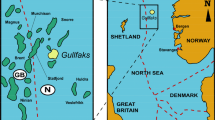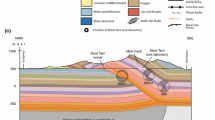Abstract
Traditionally, seismic modeling has concentrated on one-dimensional borehole modeling and two-dimensional forward modeling of basic structural-stratigraphic schemes, which are directly compared with real seismic data. Two-dimensional seismic models based on outcrop observations may aid in bridging the gap between the detail of the outcrop and the low resolution of seismic lines. Examples include the Dolomites (North Italy), the Vercors (SE France), and the High Atlas (Morocco). The seismic models are generally constructed using the following procedure: (a) construction of a detailed lithologic model based on direct outcrop observations; (b) division of the lithologic model into lithostratigraphic units; (c) assignment of petrophysical properties to these lithostratigraphic units; (d) ray tracing to compute time- or depth sections of reflectivity; (e) convolution of the reflectivity sections with source wavelets of different frequencies. The lithologic detail modeled in the case studies led to some striking results, particularly the discovery of pseudo-unconformities. Pseudo-unconformities are unconformities in seismics, but correspond to rapid changes of dip and facies in outcrop. None of the outcrop geometries studied were correctly portrayed seismically at 25-Hz peak frequency. However, in some instances the true relationship would gradually emerge at peak frequencies of 50–100 Hz. The examples given in this study demonstrate that detailed, outcrop-derived, seismic models can reveal what stratigraphic relationships and features are likely to be resolved under ideal or less-ideal conditions, and what pitfalls may befall the interpreter of real seismic data.
Similar content being viewed by others
References
Anselmetti FS (1994) Physical properties and seismic response of carbonate sediments and rocks, part C: seismic modeling of carbonates. PhD dissertation, ETH Zürich, pp.75–136
Arnaud H (1981) De la plate-forme urgonienne au bassin voconien: le Barrémo-Bédoulien des Alpes occidentales entre Isère et Buëch (Vercors méridional, Diois oriental et Dévoluy). Géol Alpine Mém Sp 12:1–804
Biddle KT, Schlager W, Rudolph KW, Bush TL (1992) Seismic model of a progradational carbonate platform, Picco di Vallandro, the dolomites, northern Italy. Am Assoc Pet Geol Bull 76:14–30
Bortfeld R (1961) Approximations of the reflection and transmission coefficients of plane longitudinal and transverse waves. Geophysics 9:485–502
Bosellini A (1984) Progradation geometries of carbonate platforms: examples from the Triassic of the dolomites, northern Italy. Sedimentology 31:1–24
Campbell CV (1967) Lamina, laminaset, bed and bedset. Sedimentology 8:7–26
Campbell AE, Stafleu J (1992) Seismic modeling of an Early Jurassic, drowned carbonate platform: Djebel Bou Dahar, High Atlas, Morocco. Am Assoc Pet Geol Bull 76:1760–1777
Cartwright JA, Haddock RC, Pinheiro LM (1993) The lateral extent of sequence boundaries. In: Williams GD, Dobb A (eds): Tectonics and seismic sequence stratigraphy. Geol Soc Spec Publ 71:15–34
Crevello PD, Warme JE, Septfontaine M, Burke R (1987) Evolution of Jurassic carbonate platforms in an active transtensional rift: High Atlas of Morocco. Am Assoc Pet Geol Bull (abstract) 71:543–544
Everts AJW, Stafleu J, Schlager W, Fouke BW, Zwart EW (1995) Stratal patterns, sediment composition and sequence stratigraphy at the margin of the Vercors platform. J Sediment Res B65:119–131
Fagin SW (1991) Seismic modeling of geologic structures — applications to exploration problems. Soc Expl Geophys, Geophysical Development Series 2, Tulsa, pp 1–269
Helland-Hansen W, Helle H, Sunde K (1994) Seismic modelling of tertiary sandstone clinothems, Spitsbergen. Basin Res (in press)
Hubral P (1977) Time migration — some ray theoretical aspects. Geophys Prospect 25:738–745
Kenter JAM, Campbell AE (1991) Sedimentation on a Jurassic carbonate platform flank: geometry, sediment fabric and related depositional structures (Djebel Bou Dahar, High Atlas, Morocco). Sediment Geol 72:1–34
Neidell NS (1991) Could the processed seismic wavelet be simpler than we think? Geophysics 56:681–690
Neidell NS, Poggiagliolmi E (1977) Stratigraphic modeling and interpretation -geophysical principles and techniques. In: Payton CE (ed) Seismic stratigraphy - applications to hydrocarbon exploration. Am Assoc Pet Geol, Memoir 26:389–415
Nosal EA, Callahan CJ, Wiley RW (1991) Ray-trace modeling for salt proximity surveys. In: Fagin SW (ed) Seismic modeling of geologic structures — applications to exploration problems. Soc Expl Geophys, Geophysical Development Series 2, Tulsa, pp 153–173
Reilly JM (1992) Seismic imaging adjacent and beneath salt diapirs, UK North Sea. First Break 10:383–397
Rudolph KW, Schlager W, Biddle KT (1989) Seismic models of a carbonate foreslope-to-basin transition, Picco di Vallandro, Dolomite Alps, northern Italy. Geology 17:453–456
Schlager W (1993) Accommodation and supply — a dual control on stratigraphic sequences. Sediment Geol 86:111–136
Schlager W, Biddle KT, Stafleu J (1991) Picco di Vallandro (Dürrenstein) —a platform-basin transition in outcrop and seismic model. Dolomieu Conference on carbonate platforms and dolomitization, Guidebook Excursion D, Ortisei, 22 pp
Stafleu J, Schlager W (1993) Pseudo-toplap in seismic models of the Schlern-Raibl contact (Sella platform, northern Italy). Basin Res 5:55–65
Stafleu J, Everts AJW, Kenter JAM (1994) Seismic models of a prograding carbonate platform: Vercors, south-east France. Mar Pet Geol 11:513–527
Stafleu J, Sonnenfeld MD (1994) Seismic models of a shelf-margin depositional sequence: upper San Andres Formation, Last Chance Canyon, New Mexico. J Sediment Res B64:481–499
Vail PR, Mitchum RM Jr (1977) Seismic stratigraphy and global changes of sea level, part 1: overview. In: Payton CE (ed) Seismic stratigraphy — applications to hydrocarbon exploration. Am Assoc Pet Geol, Memoir 26:51–52
Vail PR, Todd RG, Sangree JB (1977) Seismic stratigraphy and global changes of sea level, part 5: chronostratigraphic significance of seismic reflections. In: Payton CE (ed) Seismic stratigraphy —applications to hydrocarbon exploration. Am Assoc Pet Geol, Memoir 26:99–116
Van Hinte JE (1982) Synthetic seismic sections from biostratigraphy. In: Watkins JS, Drake CL (eds) Studies in continental margin geology. Am Assoc Pet Geol, Memoir 34:675–685
Van Wagoner JC, Mitchum RM, Campion KM, Rahmanian VD (1990) Siliciclastic sequence stratigraphy in well logs, cores, and outcrops. Am Assoc Pet Geol Methods Explor 7:1–55
Zoeppritz K (1919) Über Reflexion und Durchgang seismischer Wellen durch Unstetigkerlsfläschen: Berlin, Über Erdbebebwellen VII B, Nachr. Kön. Gesellschaft der Wissenschaften zur Göttingen, Math.-Phys., K1, 57–84
Author information
Authors and Affiliations
Rights and permissions
About this article
Cite this article
Stafleu, J., Schlager, W. Pseudo-unconformities in seismic models of large outcrops. Geol Rundsch 84, 761–769 (1995). https://doi.org/10.1007/BF00240566
Received:
Accepted:
Issue Date:
DOI: https://doi.org/10.1007/BF00240566




